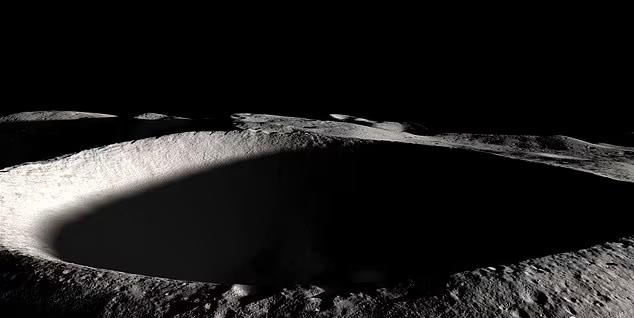A new study by a team of researchers at the University of Arizona in the United States shows that frozen water is preserved in the rocks on the lunar surface, and the preservation of water is due to "magnetic anomalies" around certain craters, which deflect the solar wind to avoid the decomposition of frozen water by high-energy particles.
Some spacecraft have reportedly found evidence of frozen water deep in the craters of the moon's polar regions, where temperatures could drop to -250C° as sunlight cannot penetrate dark craters.

Some spacecraft have found evidence of frozen water deep in the craters of the moon's polar regions.
Since high-energy particles (the solar wind) from the sun can enter rocky interiors and break down ice molecule by molecule, scientists are puzzled by how the lunar ice has remained intact for millions of years.
A new study by a team of researchers at the University of Arizona has found that frozen water is preserved due to "magnetic anomalies" around certain craters that deflect the solar wind, thus avoiding the decomposition of frozen water by energetic particles.
Study lead author Lon Hood presented their theory at the Lunar and Planetary Science Conference in Houston, which involved data collected in the 1970s.
In 1971 and 1972, Apollo 15 and 16 astronauts detected the first magnetic anomalies on the moon. They measured areas of anomalous magnetic forces, some of which are hundreds of miles wide.
Hood's team believes they were created 4 billion years ago, when the moon had its own magnetic field, protecting it from solar radiation.
Frozen water is preserved due to "magnetic anomalies" around certain craters that deflect the solar wind, thus avoiding the decomposition of frozen water by energetic particles.
This ancient magnetic field is thought to be the result of an iron-rich asteroid crashing into the lunar surface, heating the rocks until they turn into melts, and the resulting material is permanently magnetized.
Scientists believe there are thousands of such asteroids, of varying sizes, scattered across the lunar surface.
Hood used data from Japan's Glow Night mission to map Antarctica in detail, and he found that at least two craters overlapped with these anomalies.
These remnants are thousands of times weaker than the magnetic field around Earth, not enough to hold an atmosphere, but do deflect the solar wind.
Hood said the research is important because it could help future space missions better plan landing sites, mining sites and sites for scientific analysis.
Once extracted from the rocks, experts say, the frozen water could one day be used to sustain future human settlements, providing both drinks and fuel components.
Working near, inside, or around these protected water sources will save astronauts the cost of carrying water to the moon and make it more self-sustaining.
Text/Nandu reporter Chen Lin